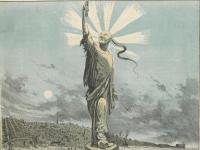This blog post was written by Ashley Jones, a Cultural Fieldwork Intern from the Temple’s School of Education.
Generally, cartoons are meant to amuse you. Your students may think of their favorite TV shows or comics when they hear the word “cartoon.” Students, however, have more than likely been exposed to political cartoons as well, through newspapers or the internet. They may not fully understand the vital role these types of cartoons can play in persuading public opinion and politics.
Political cartoons generally deal with current issues or events at the time of their publication, and are therefore great primary sources for use in the classroom. Students can analyze political cartoons to reveal the issue behind the satire and to understand how people and policies were influenced by these types of propaganda. In order to do this, students will need some basic background on what a political cartoon is (and is not). Teachers will need to model how to “read” and interpret a political cartoon by analyzing one with the class as a whole. Teachers can choose a modern political cartoon to do this, one that deals with an issue relevant to students’ lives to capture interest.
While working on a unit on immigration in my own classroom, I would introduce the cartoons below while discussing how the American people accepted or rejected immigrants in the 1800s. Given the current political climate and controversy surrounding immigration, students will be engaged in learning how immigration has always been a hot topic in the United States. Students can analyze each cartoon using a political cartoon analysis guide, discuss these cartoons in small groups, or look at them as a supplement to their textbooks.
The Historical Society of Pennsylvania has many political cartoons on the topic of immigration. The cartoons showcase Americans’ changing attitudes over time on different immigrant groups and how those views have influenced various policies. Here are two examples from the 1880s. The first titled, A Statue for our Harbor, printed in 1881, highlights American attitudes toward Chinese immigrants and the stereotypes that the Chinese were ruining the American culture and workforce. Uncle Sam’s Lodging House, which was printed in 1882, exemplifies American attitudes that the Irish were too preoccupied with their native land’s issues to assimilate to American society. Other immigrant ethnic groups are depicted in common stereotypes of the time.
I would focus the lesson on the cartoons using an analysis worksheet. Students can jot down their initial reaction to the cartoon, stating what message(s) they think the cartoon is trying to convey, what the artist wants to persuade the audience to think, or more basically, identifying the intended audience. These are great anticipatory sets, because they can be done quickly at the beginning of class to peak students’ interest on the day’s topic. After students give their initial reactions to the cartoons, the teacher can provide more background information and help students work through interpreting the cartoon more deeply. Students can then revisit their first thoughts and revise them to either reinforce what they already knew or change what they thought they knew.
Analyzing political cartoons is an appropriate activity for students in grades 6 through 12. These can be modified and differentiated for students across all levels. These will be especially useful for students below grade-level reading or ELL students. Visual representations are helpful in providing different ways for students to approach material and absorb information.

